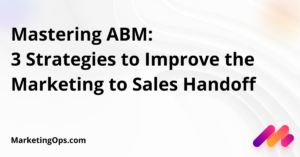Have you been pouring dollars and process improvements into your marketing stack for years, but find that you still can’t tell if your plans are succeeding?
Aligning planning—where resources, money, time, and people are allocated to achieve goals—with outcomes themselves often proves elusive for marketing departments.
Spreadsheets and slides provide limited to no visibility into what you’ve spent this year, what next quarter’s budget should be, or which campaigns are working.
You’re operating in a fog. But there’s a way to clear the haze.
Read on to uncover the three most common pain points felt by marketing organizations trapped in dysfunction. Those pain points manifest themselves in a number of symptoms to create a fog of marketing that limits what marketers can do. And learn how the marketing business acceleration operating model can get you the visibility you need.
Three common pain points
According to Gartner, 37% of marketers say proving their value is one of their top three
biggest challenges. Indeed, it’s hard to demonstrate your worth when you’re in a chaotic state of operations. Our primer on marketing business acceleration unpacks marketing departments’ three most commonly felt pain points:
Your work is too tactical. You’re consumed with the low-level configuration of martech tools instead of giving the CMO visibility into how dispersed teams are implementing marketing goals and plans.
Your insight is limited. You’re using marketing data based on snapshots that are disconnected from critical dependencies, so you can’t serve as a forward-looking strategic resource.
Your organization is fragmented. You’re engaged in episodic, one-off planning processes or in shadow planning that diverges from marketing strategy, inhibiting collaboration and creativity.
The fog of marketing
We call this chaotic state the fog of marketing. It limits a CMO’s ability to plan, execute, and optimize at speed across geographies, departments, and campaigns.
Below are six real examples of how the most common pain points manifest themselves to create a fog of marketing. Do any of these sound familiar?
- The goal of your marketing plan is to secure your budget, not to drive outcomes.
- Copies of your marketing plan are shared via slides, documents, and spreadsheets, resulting in accuracy and versioning errors.
- Answering simple questions like, “What is the current marketing plan and how are we doing against it?” requires an inordinate amount of research, forensics, and guesswork.
- You don’t learn how close you came to spending against your budget plan until the end of the quarter when it’s too late to reallocate dollars.
- Tools in your martech stack have tactical reporting capabilities, but none of them can tell you what your marketing ROI is.
- When marketing numbers don’t align with finance, you know which version of the truth the CEO will trust. And it’s not yours.
How the fog limits what marketers can do
Experiencing any of these symptoms of operating in the fog can hold your marketing organization captive in a reactive support role that it can’t climb out of. And when you’re stuck, there’s little room for growth. Our primer on marketing business acceleration highlights three significant ways that the fog limits what marketers can do.
Marketers can’t see what they’re spending
According to Forrester, 63% of organizations use spreadsheets for budgeting and planning. With budgets housed in multiple spreadsheets, disconnected from both strategy and execution, nobody knows exactly what was spent—or made—on campaigns in any given week, month, or quarter.
Many marketers can obtain the information, but only through laborious manual processes. In fact, Forrester found that budgeting and spending management is a mostly or completely manual process for 39% of marketing organizations. Manual processes are error-prone, hog time and resources, and don’t allow for quick strategic pivots.
Under these conditions, it’s tough to reconcile actual spending with forecasts. And it’s nearly impossible to make accurate future forecasts. Worse still, CMOs are unable to prove the ROI of marketing, whether to the rest of the C-suite or themselves.
Marketers can’t see how strategy and execution connect
Ideally, marketing strategy should feed directly into plans that marketing teams can easily access, follow, and measure their performance against.
The reality is that plans are locked up in various spreadsheets. Decisions on strategy and execution are made in isolation by dispersed teams. Execution is uncoordinated and drifts from planning. Strategy all but disappears beneath the thick blanket of marketing fog.
To make matters worse, teams have no picture of how their day-to-day work is contributing to overall marketing goals and their company’s success.
Marketers can’t see the impact of their decisions
To make confident and informed strategic decisions, marketers need easy access to fresh, timely, and trustworthy performance data. But because marketing data tends to be siloed in various tools and systems, marketers are often left not knowing which tactics and campaigns are working best.
Many marketers aren’t confident that the data that they can access is accurate and comprehensive. In fact, a survey that Uptempo conducted showed that 61% of marketing leaders don’t have confidence in their own data to use ROI in decision-making.
Without trustworthy data, marketers can’t make confident, quick decisions about what to do next—whether it’s a major initiative or minor deviation from the plan.
There’s an answer: marketing business acceleration
Is there any hope that a marketer can clear away all this fog?
In fact, there is. With a new operating model that we call marketing business acceleration.
It closes the gaps between planning, spending, and execution silos to provide a clear picture of marketing ROI. It gives real-time insights based on accurate and trusted data captured at the operational edge, not in isolated spreadsheets. And it supports continuous planning, forecasting, and spend management so that marketers can react to changes.
Every other department in the modern enterprise except marketing has a system-of-record framework that allows executives to make and implement strategies, meet goals, and decide budgets and resource allocation.
Marketing business acceleration provides a system of record for the four forgotten domains of marketing operations: planning, budget management, work and digital asset management, and performance management.
Don’t believe it’s possible? TMD Friction achieved a more agile marketing planning process, increased transparency, and improved collaboration after implementing a marketing resource management platform.
Marketing business acceleration provides a map to unleash the potential of marketing operations and turn it into an engine for growth. It prescribes a series of maturity levels, each of which unlocks a key capability: visibility, velocity, and agility. Ultimately, your destination will be unprecedented performance.
It’s time to start the journey to clear the fog. Are you ready? Read The CMO’s Primer for Marketing Business Acceleration today and find out.







